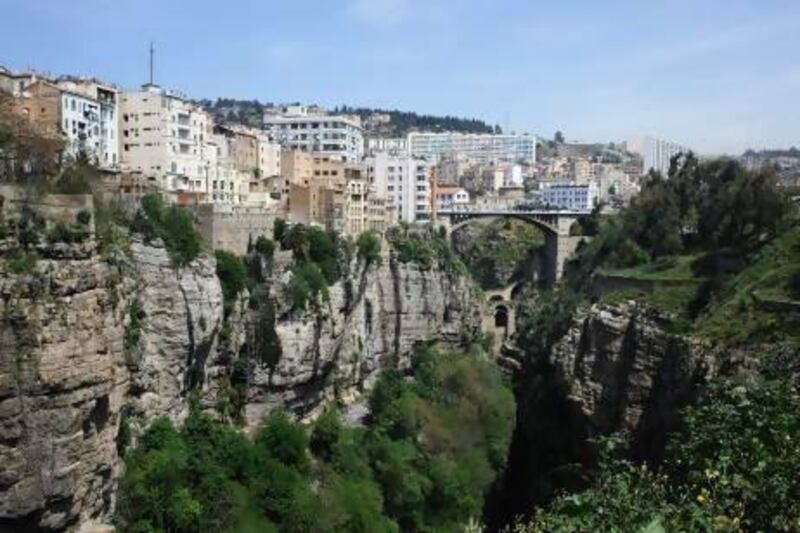CONSTANTINE, ALGERIA // "You do not introduce Constantine. She introduces herself, and you salute her. She reveals herself and we discover each other."
So wrote Malek Haddad, an Algerian poet born in 1927 in Constantine - a city not so much built as draped, clinging to ravines and peaks that soar above the river Rhumel.
Algeria's third city is tucked away 100 kilometres inland from the country's long Mediterranean coast. The road sneaks up on the city, snaking up the mountains. It weaves through craggy passes and tunnels blasted in the rock, past forests mirrored in wide lakes, before turning a steep corner and confronting you with Constantine.
"She bursts forth like a glance from the dawn, and she runs on a horizon that she astonishes and raises up," wrote Haddad in the first lines of a series of articles for the Algerian newspaper Annasr in 1966.
He called the first part of the love song to his home A key for Cirta, the name for the city when it was part of the kingdom of Numidia, more than 2,000 years ago, before the Phoenicians, Romans, Ottomans or French started adding grandiose, mismatched architecture to its peaks and plateaus.
As cupolas, minarets and gilded statues appear on the horizon, cliffs on the side of the road drop away suddenly and sheerly, and the Rhumel appears hundreds of metres below. The river in spring is rushing and deep, pouring over rocks in a foaming waterfall, but so far down that its sound is just a muffled splashing.
The road hugs the mountain and curves up towards the city. Bridges begin to appear; the bones that hold the city together. Some, like the slender black suspension bridge and the hefty viaduct built a century ago, are for the cars honking impatiently as they sit in traffic suspended as much as 300 metres above the rocky gorge full of cactus. Others are for pedestrians, elegant folk - one man in a white linen suit and a fez, women in long coloured dresses - strolling and haggling with street vendors as they cross from one mountaintop of their graceful, peculiar city to another.
Caves carved into the rock, believed to be signs of precipitous prehistoric settlements here, peer down over the sides of the gorge. By the time the Numidian empire became the first of several dynasties to spread its warlike way across North Africa, the defensive possibilities of the town on top of the mountain were recognised and a royal family, the Massyli, ruled from here.
It was renamed for the Roman emperor in the 4th century. The name stuck, rendered as Qasantina in Arabic, as the city became Arab hundreds of years later. The old city, walled and fortified, has features of Roman architecture remaining today.
The buildings, official ones such as courthouses as well as elegant residential blocks with strings of washing hanging out over the gorge, owe most of their style to the long French colonial period, though this is not a city of cool blue-and-white like the capital. The warm, faded oranges and pinks of some of the mansions remind one of Italy, and there are architectural surprises. An enormous, modern white mosque stretches giant minarets skyward, and one of the universities was designed by the late Brazilian architect Oscar Niemeyer.
Business here has long centred on the region's extensive agriculture, and merchants from Europe gathered here centuries ago to trade.There are factories on the banks of the river, and the city still makes much of its money selling the produce of the country's verdant north to its desert south.
But its days of fame and influence seem to be over. Few people come to Algeria simply as visitors, put off by slow visa processes and occasional instability.
"This is the problem of Constantine," said Amira Rabia, 24, a student who has lived most of her life here. "It's a beautiful city and it has its own culture, but people don't know anything about Constantine."
The city has been selected by the Arab League's cultural arm to be the capital of Arab culture in 2015, which Ms Rabia hopes will bring more people - and more fun.
The government has promised to invest heavily in preparation, including building annexes to an arts centre and planning festivals.
"It would be an awesome thing if we had more tourists," said Ms Rabia, explaining the traditions of songs, a particular kind of wedding gown, and a local variant of the dish chakhchoukha that make the city special.
She hopes that some of the investment goes into places for young people to spend their evenings. There is no reason for things to be stuck in the past, she said.
"I think everything should be balanced. I don't want to lose my traditions and be 100 per cent modern ... I want to have a little bit of both, because when you lose your origins, you're nothing."
twitter: For breaking news from the Gulf, the Middle East and around the globe follow The National World. Follow us





